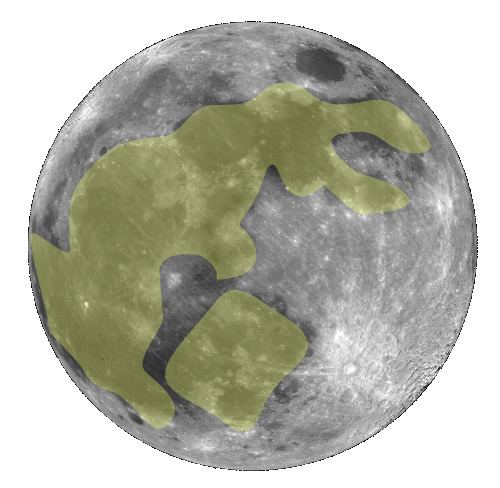Chinese 月兔 Hanyu Pinyin Chinese 玉兔 | Jyutping jyut tou Literal meaning Jade rabbit | |
 | ||
The moon rabbit in folklore is a rabbit that lives on the Moon, based on pareidolia that identifies the markings of the Moon as a rabbit. The story exists in many cultures, prominently in Asian folklore and Aztec mythology. In East Asia, it is seen pounding in a mortar and pestle, but the contents of the mortar differ among Chinese, Japanese, and Korean folklore. In Chinese folklore, it is often portrayed as a companion of the Moon goddess Chang'e, constantly pounding the elixir of life for her; but in Japanese and Korean versions, it is pounding the ingredients for rice cake.
Contents
History
An early mention that there is a rabbit on the moon appears in the Chu Ci, a Western Han anthology of Chinese poems from the Warring States period, which notes that along with a toad, there is a rabbit on the Moon who constantly pounds herbs for the immortals. This notion is supported by later texts, including the Song-era Taiping Imperial Reader. Han Dynasty poets call the rabbit on the Moon the "Jade Rabbit" (玉兔) or the "Gold Rabbit" (金兔), and these phrases were often used in place of the word for the Moon. A famous poet of Tang China, Li Bai, relates how "[t]he rabbit in the Moon pounds the medicine in vain" in his poem "The Old Dust."
Asian folklore
In the Buddhist Jataka tales (Tale 316), a monkey, an otter, a jackal, and a rabbit resolved to practice charity on the day of the full moon (Uposatha), believing a demonstration of great virtue would earn a great reward. When an old man begged for food, the monkey gathered fruits from the trees and the otter collected fish, while the jackal wrongfully pilfered a lizard and a pot of milk-curd. The rabbit, who knew only how to gather grass, instead offered its own body, throwing itself into a fire the man had built. The rabbit, however, was not burnt. The old man revealed himself to be Śakra and, touched by the rabbit's virtue, drew the likeness of the rabbit on the Moon for all to see. It is said the lunar image is still draped in the smoke that rose when the rabbit cast itself into the fire. A version of this story can be found in the Japanese anthology Konjaku Monogatarishū, where the rabbit's companions are a fox, instead of a jackal, and a monkey. The legend is popular and part of local folklore throughout Asia in China, Japan, Korea, Sri Lanka, Thailand, Vietnam, Cambodia and Myanmar. The legend also gave rise to the Mid-Autumn Festival of China and Vietnam, Tsukimi of Japan and Chuseok of Korea which all celebrate the legend of the moon rabbit.
Indigenous American folklore
Similar legends occur in Mexican folklore, where people also identified the markings on the Moon as a rabbit. According to an Aztec legend, the god Quetzalcoatl, then living on Earth as a man, started on a journey and, after walking for a long time, became hungry and tired. With no food or water around, he thought he would die. Then a rabbit grazing nearby offered herself as food to save his life. Quetzalcoatl, moved by the rabbit's noble offering, elevated her to the Moon, then lowered her back to Earth and told her, "You may be just a rabbit, but everyone will remember you; there is your image in light, for all people and for all times."
Another Mesoamerican legend tells of the brave and noble sacrifice of Nanahuatzin during the creation of the fifth sun. Humble Nanahuatzin sacrificed himself in fire to become the new sun, but the wealthy god Tecciztecatl hesitated four times before he finally set himself alight to become the Moon. Due to Tecciztecatl's cowardice, the gods felt that the Moon should not be as bright as the sun, so one of the gods threw a rabbit at his face to diminish his light. It is also said that Tecciztecatl was in the form of a rabbit when he sacrificed himself to become the Moon, casting his shadow there.
A Native American (Cree) legend tells a different variation, about a young rabbit who wished to ride the Moon. Only the crane was willing to take him. The trip stretched Crane's legs as the heavy rabbit held them tightly, leaving them elongated as cranes' legs are now. When they reached the Moon Rabbit touched Crane's head with a bleeding paw, leaving the red mark cranes wear to this day. According to the legend, on clear nights, Rabbit can still be seen riding the Moon.
